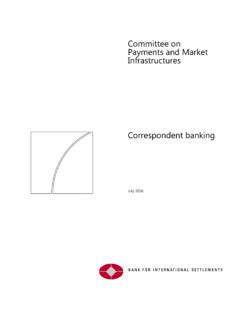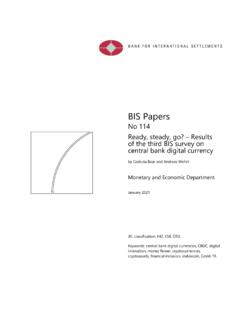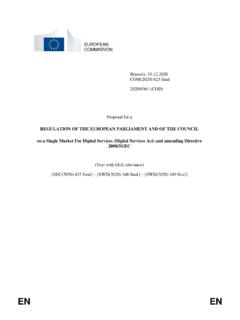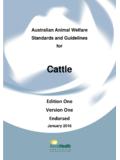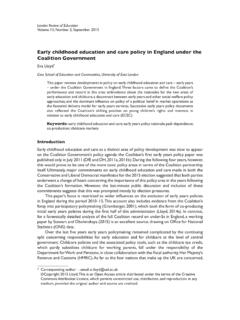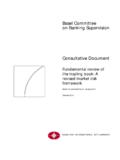Transcription of Electronic trading in fixed income markets
1 markets Committee Electronic trading in fixed income markets Report submitted by a Study Group established by the markets Committee The Group was chaired by Joachim Nagel (Deutsche Bundesbank) January 2016 This publication is available on the BIS website ( ). Bank for International Settlements 2016. All rights reserved. Brief excerpts may be reproduced or translated provided the source is stated. ISBN 978-92-9197-420-7 (online) MC Electronic trading in fixed income markets iii Preface Electronic trading has become an increasingly important part of the fixed income market landscape in recent years.
2 It has contributed to changes in the market structure, the process of price discovery and the nature of liquidity provision. The rise of Electronic trading has enabled a greater use of automated trading (including algorithmic and high-frequency trading ) in fixed income futures and parts of cash bond markets . Innovative trading venues and protocols (reinforced by changes in the nature of intermediation) have proliferated, and new market participants have emerged. For some fixed income securities, electronification has reached a level similar to that in equity and foreign exchange markets , but for other instruments the take-up is lagging.
3 Against this background, in January 2015 the markets Committee established a Study Group on Electronic trading in fixed income markets (chaired by Joachim Nagel, Deutsche Bundesbank) to explore how ongoing developments are affecting market structure and functioning. This report presents the Group s findings. It is based on information from a range of sources, including structured interviews with market participants and a survey of Electronic trading platforms. It argues that advances in technology and regulatory changes have significantly affected the economics of intermediation in fixed income markets and that electronification is changing the behaviour of investors.
4 The rise of Electronic trading is creating efficiencies for many market participants, improving market quality in normal times, lowering transaction costs and reducing market segmentation, while at the same time posing challenges to some participants. Electronic trading , in particular automated and high-frequency trading , also poses a number of challenges to policymakers, including the need to monitor its effect on market liquidity and functioning and to ensure appropriate governance of automated trading . The report identifies a number of core areas for further policy assessment.
5 The report is a timely and important contribution to the ongoing discussions about the quality of market functioning and its implication for market design. Guy Debelle Chair, markets Committee Assistant Governor, Reserve Bank of Australia MC Electronic trading in fixed income markets v Contents Executive summary .. 1 1. Introduction .. 3 2. What is Electronic trading and how has it evolved? .. 4 What do we mean by Electronic trading ? .. 4 How has Electronic trading evolved in fixed income markets ? .. 4 The voice era: an over-the-counter (OTC) market with dealers at its core .. 4 The rise of Electronic trading in the inter-dealer market.
6 5 The rise of Electronic trading in the dealer-client segment .. 6 Automated trading and the rise of new market-makers .. 7 Box 1: What are automated trading and high-frequency trading ? .. 8 3. What is the current state of Electronic trading in fixed income markets ? .. 8 fixed income futures .. 9 Box 2: Key drivers of Electronic trading .. 10 Sovereign bond markets .. 10 Interest rate swaps .. 12 Corporate bonds .. 12 A survey of Electronic trading platforms .. 13 4. impact of Electronic trading .. 15 impact on infrastructure and the market ecosystem .. 15 Platform innovation and competition .. 15 Evolving trading conventions .. 16 impact on market participants.
7 16 Suppliers of intermediation .. 16 Box 3: Dealers as intermediaries: principal vs agent .. 18 Demanders of intermediation .. 19 How does Electronic trading affect market quality? .. 20 impact of platform trading .. 20 Box 4: Market quality .. 21 impact of ultra-fast traders on market quality .. 22 vi MC Electronic trading in fixed income markets Automated trading in bond markets .. 23 impact of electronification in fixed income markets suggestive evidence .. 23 Further insights from other asset classes and various case studies .. 25 5. Challenges for policy .. 26 Data, disclosure and monitoring .. 26 Market quality and stability.
8 27 Risks and risk management .. 27 trading practices and regulation .. 28 Appendix A: Study Group mandate .. 31 Key Questions Stage 1. Trends and drivers .. 31 Key Questions Stage 2. Potential implications for market functioning .. 31 Process .. 32 Appendix B: impact of automated trading insights from other asset classes .. 33 Appendix C: Case studies .. 35 The US Treasury market on 15 October 2014 .. 35 The bund tantrum of May June 2015 .. 36 Gyrations in JGB futures markets .. 37 References .. 39 Glossary .. 42 Members of the Study Group .. 44 MC Electronic trading in fixed income markets 1 Executive summary Electronic trading in fixed income markets has been growing steadily.
9 In many jurisdictions , it has supplanted voice trading as the new standard for many fixed income asset classes. Electronification, ie the rising use of Electronic trading technology, has been driven by a combination of factors. These include: (i) advances in technology; (ii) changes in regulation; and (iii) changes in the structure and liquidity characteristics of specific markets . For some fixed income securities, electronification has reached a level similar to that in equity and foreign exchange markets . US Treasury markets are a prime example of a highly Electronic fixed income market, in which a high proportion of trading in benchmark securities is done using automated trading .
10 However, fixed income markets still lag developments in other asset classes due to their greater heterogeneity and complexity. This report highlights two specific areas of rapid evolution in fixed income markets . First, trading is becoming more automated in the most liquid and standardised parts of fixed income markets , often importing technology developed in other asset classes. Traditional dealers too are using technology to improve the efficiency of their market-making. And non-bank liquidity providers are searching for ways to trade directly with end investors using direct Electronic connections.










